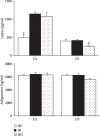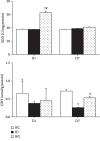Dietary Supplemental Glutamine Enhances the Percentage of Circulating Endothelial Progenitor Cells in Mice with High-Fat Diet-Induced Obesity Subjected to Hind Limb Ischemia
- PMID: 32104148
- PMCID: PMC7040416
- DOI: 10.1155/2020/3153186
Dietary Supplemental Glutamine Enhances the Percentage of Circulating Endothelial Progenitor Cells in Mice with High-Fat Diet-Induced Obesity Subjected to Hind Limb Ischemia
Abstract
This study investigated whether glutamine (GLN) pretreatment can enhance circulating endothelial progenitor cells (EPCs) and attenuate inflammatory reaction in high-fat diet-induced obese mice with limb ischemia. Mice were assigned to a normal control (NC), high-fat control (HC), limb ischemia (HI), and GLN limb ischemia (HG) groups. The NC group provided chow diet and treated as a negative control. Mice in the HC and HI groups were fed a high-fat diet which 60% energy provided by fat for 8 weeks. Mice in the HG group were fed the same diet for 4 weeks and then transferred to a high-fat diet with 25% of total protein nitrogen provided as GLN to replace part of the casein for the subsequent 4 weeks. After feeding 8 weeks, mice in the HC group were sham-operated, while the HI and HG groups underwent an operation to induce limb ischemia. All mice except the NC group were euthanized on either day 1 or 7 after the operation. The results showed that the 8 weeks' high-fat diet feeding resulted in obesity. The HG group had higher circulating EPCs on day 1 while muscle vascular endothelial growth factor, matrix metalloproteinase-9, and hypoxia-inducible factor-1 gene expressions were higher on day 7 postischemia than those of the HI group. The superoxide dismutase activity and reduced glutathione content in affected muscles were higher, whereas mRNA expressions of interleukin-6 and tumor necrosis factor-α were lower in the HG than those in the HI group. These findings suggest that obese mice pretreated with GLN-supplemented high-fat diet increased circulating EPC percentage, enhanced the antioxidant capacity, and attenuated inflammatory reactions in response to limb ischemia.
Copyright © 2020 Chi-Hsuan Ko et al.
Conflict of interest statement
The authors declare that there are no competing financial or personal interests in this study.
Figures





Similar articles
-
Arginine pretreatment enhances circulating endothelial progenitor cell population and attenuates inflammatory response in high-fat diet-induced obese mice with limb ischemia.Nutr Res. 2018 May;53:67-76. doi: 10.1016/j.nutres.2018.03.010. Epub 2018 Mar 23. Nutr Res. 2018. PMID: 29685627
-
Dietary glutamine supplementation enhances endothelial progenitor cell mobilization in streptozotocin-induced diabetic mice subjected to limb ischemia.J Nutr Biochem. 2017 Feb;40:86-94. doi: 10.1016/j.jnutbio.2016.10.010. Epub 2016 Oct 29. J Nutr Biochem. 2017. PMID: 27865159
-
Glutamine administration promotes hepatic glucose homeostasis through regulating the PI3K/Akt pathway in high-fat diet-induced obese mice with limb ischemia.Nutr Res. 2019 Aug;68:45-53. doi: 10.1016/j.nutres.2019.05.008. Epub 2019 Jun 26. Nutr Res. 2019. PMID: 31419579
-
Inhalation of Fine Particulate Matter Impairs Endothelial Progenitor Cell Function Via Pulmonary Oxidative Stress.Arterioscler Thromb Vasc Biol. 2018 Jan;38(1):131-142. doi: 10.1161/ATVBAHA.117.309971. Epub 2017 Nov 30. Arterioscler Thromb Vasc Biol. 2018. PMID: 29191925 Free PMC article.
-
Glutamine Administration Modulates Endothelial Progenitor Cell and Lung Injury in Septic Mice.Shock. 2016 Nov;46(5):587-592. doi: 10.1097/SHK.0000000000000621. Shock. 2016. PMID: 27058045
Cited by
-
Epstein-Barr Virus DNA Exacerbates Colitis Symptoms in a Mouse Model of Inflammatory Bowel Disease.Viruses. 2021 Jun 29;13(7):1272. doi: 10.3390/v13071272. Viruses. 2021. PMID: 34210024 Free PMC article.
-
Fasting Therapy Contributes to the Improvement of Endothelial Function and Decline in Vascular Injury-Related Markers in Overweight and Obese Individuals via Activating Autophagy of Endothelial Progenitor Cells.Evid Based Complement Alternat Med. 2020 Jul 27;2020:3576030. doi: 10.1155/2020/3576030. eCollection 2020. Evid Based Complement Alternat Med. 2020. PMID: 32802124 Free PMC article.
References
-
- Hicks C. W., Yang C., Ndumele C. E., et al. Associations of obesity with incident hospitalization related to peripheral artery disease and critical limb ischemia in the ARIC study. The Journal of American Heart Association. 2018;7(16, article e008644) doi: 10.1161/jaha.118.008644. - DOI - PMC - PubMed
MeSH terms
Substances
LinkOut - more resources
Full Text Sources
Medical

